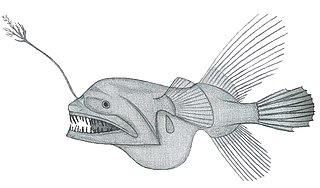
Leftvents are a family, the Linophrynidae, of marine ray-finned fishes which is classified within the suborder Ceratioidei, the deep sea anglerfishes. These fishes are found in the Atlantic, Indian and Pacific Oceans.

Fanfins or hairy anglerfish are a family, Caulophrynidae, of marine ray-finned fishes within the order Lophiiformes, the anglerfishes. The fishes in this family are found almost around the world in the deeper, aphotic waters of the oceans.

Haplophryne mollis, the ghostly seadevil or soft leftvent angler, is a species of anglerfish in the family Linophrynidae and is the only species in the genus Haplophryne. It is found in the bathypelagic and mesopelagic zones of tropical and subtropical parts of the world's oceans at depths down to about 2,250 m (7,400 ft).

Caulophryne polynema is a species of marine ray-finned fish belonging to the family Caulophrynidae, the fanfins. This species is a deepwater species which is found in the Atlantic and Pacific Oceans. Like other deepwater anglerfishes it shows extreme sexual dimorphism with the males being much smaller than the females and acting as sexual parasites of the females.

Caulophryne is a genus of marine ray-finned fishes belonging to the family Caulophrynidae, the fanfins or hairy anglerfishes. These fishes are found throughout the non-polar oceans of the world.

Acentrophryne is a genus of deep-sea anglerfish in the family Linophrynidae, the leftvents, known from the eastern Pacific Ocean. Fossils of the type species, A. longidens, have been found in Late Miocene-aged Puente Formation of Rosedale, California.

Borophryne apogon, the netdevil, or greedy seadevil, is a species of leftvent anglerfish known today from the waters of the eastern Pacific Ocean off the Central American coast. It is found at depths down to around 1,750 m (5,700 ft). This species grows to a length of 8.3 centimetres (3.3 in) TL. A fossil specimen of this species has been found in the Los Angeles Basin dating back to the Late Miocene, some eight million years ago.

Linophryne, the bearded seadevils, is a genus of marine ray-finned fishes belonging to the family Linophrynidae, the leftvents. These deep sea anglerfishes are found in the Atlantic, Indian and Pacific Oceans.
Chirophryne is a monospecific genus of marine ray-finned fish belonging to the family Oneirodidae, the dreamers, a family of deep sea anglerfishes. The only species in the gneus is Chirophryne xenolophus, the longhand dreamer. This species is known from a few locations in the Atlantic and Pacific Oceans.

Danaphryne is a monospecific genus of marine ray-finned fish belonging to the family Oneirodidae, the dreamers, a family of deep sea anglerfishes. The only species in the genus is Danaphryne nigrifilis which is found in the tropical and temperate regions of all of the world's oceans.

Linophryne algibarbata is a species of marine ray-finned fish beloning to the family Linophrynidae, the leftvents. This fish occurs im the North Atlantic Ocean.

Caulophryne pelagica is a species of marine ray-finned fish belonging to the family Caulophrynidae, the fanfins. This species is a deepwater species which is found in the eastern Atlantic, Indian Ocean, Pacific Ocean and Southern Ocean. Its biology is little known but similar species show extreme sexual dimorphism with the very small males seeking out and attaching themselves to the much larger females and becoming parasites of the females.

Caulophryne jordani, the fanfin angler, is a species of marine ray-finned fish belonging to the family Caulophrynidae, the fanfins. This species is a deepwater species which is found in Oceanic waters around the world. Like other deepwater anglerfishes it shows extreme sexual dimorphism with the males being much smaller than the females and acting as sexual parasites of the females.
Caulophryne bacescui of marine ray-finned fishes belonging to the family Caulophrynidae, the fanfins or hairy anglerfishes. It is known from a single specimen collected from the Eastern Pacific Ocean.
Linophryne macrodon is a species of marine ray-finned fish belonging to the family Linophrynidae, the leftvents, a group of deep water anglerfishes., that live in waters 300 to 1000 m deep in theeastern pacific and western Atlantic Oceans.

Chaenophryne longiceps, the can-opener smoothdream, longhead dreamer or smooth-head dreamer, is a species of marine ray-finned fish belonging to the family Oneirodidae, the dreamers, a family of deep sea anglerfishes. This predatory, deep-sea fish is found in tropical and subtropical oceans around the world. Like other deep-sea anglerfishes, it is sexually dimorphic with the metamorphosed females dwarfing the metamorphosed males, though the males are not sexual parasites.

Acentrophryne dolichonema is a species of marine ray-finned fish belonging to the family Linophrynidae, the leftvents, a family of deep sea anglerfishes. This species is only known from the eastern Pacific Ocean off the coast of Peru.
Chaenophryne melanorhabdus is a species of marine ray-finned fish belonging to the family Oneirodidae, the dreamers, a family of deep-sea anglerfishes. This predatory, deep-sea fish is found in the Pacific Ocean. Like other deep-sea anglerfishes, dreamers are sexually dimorphic, with the matamorphosed females dwarfing the metamorphosed males. The males are not sexual parasites.

Acentrophryne longidens is a species of marine ray-finned fish belonging to the family Linophryidae, the leftvents, a family of deep sea anglerfishes. This species is only known from the eastern Pacific Ocean off the coast of Costa Rica and Panama.

Linophryne lucifer is a species of marine ray-finned fish belonging to the family Linophrynidae, the leftvents, a group of deep water anglerfishes. This species is found in the North Atlantic Ocean. It is the type species of the genus Linophryne.














